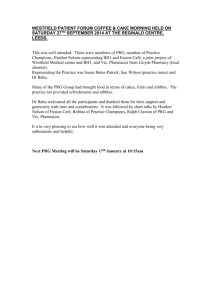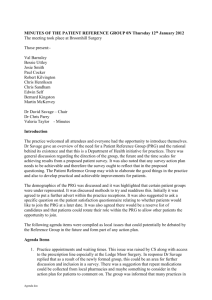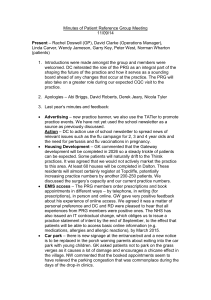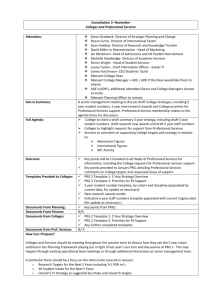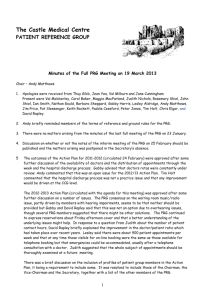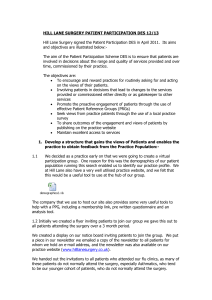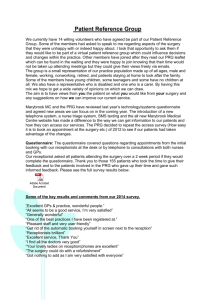School of Medicine PRG Report 13-14
advertisement
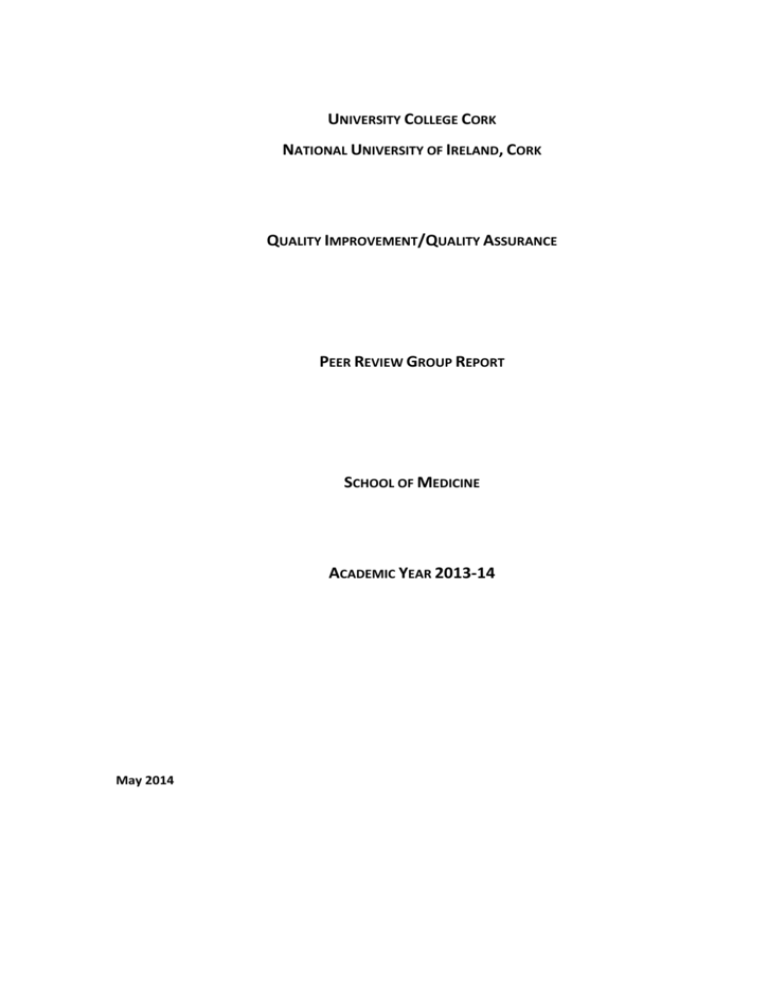
UNIVERSITY COLLEGE CORK NATIONAL UNIVERSITY OF IRELAND, CORK QUALITY IMPROVEMENT/QUALITY ASSURANCE PEER REVIEW GROUP REPORT SCHOOL OF MEDICINE ACADEMIC YEAR 2013-14 May 2014 PEER REVIEW GROUP MEMBERS Name Affiliation Institution Role Professor Claire School of English and University College Rapporteur Connolly member of the Cork, Ireland Quality Promotion Committee Ms Áine Flynn Academic University College Secretariat, Cork, Ireland Rapporteur Registrar’s Office Professor Alan Former Professor of Royal College of Johnson Biochemistry and Surgeons, Ireland Chair Dean Professor Jean Ker Professor in Medical University of Education and Dundee, Scotland Member Director of the Clinical Skills Centre Dr Jason Last Associate Dean, University College Programmes and Dublin, Ireland Member Educational Innovation, UCD School of Medicine and Medical Science Professor Jill Professor (General University of Morrison Practice) and Dean Glasgow, Scotland for Learning and Teaching in the College of Medical, Veterinary and Life Sciences TIMETABLE OF THE SITE VISIT Timetable (see appendix A) Page 2 of 22 Member Suitability and adequacy of the timetable The Peer Review Group (PRG) was pleased to meet a wide variety of staff and students and to have the opportunity to visit some of the administrative and clinical facilities. The PRG was disappointed that the interns who had been invited to meet with them did not attend. The PRG was also somewhat disappointed that the Head of College, Medicine and Health, was not present and instead had to engage with the PRG by teleconference. The PRG found the timetable to be very full. PEER REVIEW Methodology The PRG divided its main responsibilities nominally but with extensive sharing of information and ideas. The PRG worked as a team and findings and recommendations within this report reflect the views of all members of the PRG. Site Visit The site visit to UCC and the School of Medicine gave the team an opportunity to have a reasonably comprehensive coverage of all activities of the School and to extend the information provided in the Self-Assessment Report (SAR). Members of the PRG visited: Brookfield Health Sciences Complex Cork University Hospital (CUH) School of Medicine administrative office The PRG did not visit the Western Gateway Building, which houses laboratory sciences departments and related facilities, nor any additional clinical sites. PRG Report The following points describe how the PRG Report was constructed: Initial meeting and agreement of responsibilities by members of the PRG, as set out above. Professor Alan Johnson agreed to act as chair, with Ms Áine Flynn and Professor Claire Connolly as rapporteurs. On-going discussions amongst PRG members; exchange of individual reviewers’ recorded notes throughout the review process At the end of each day, the PRG conducted a review of the information received; and discussed meetings with staff and stakeholders as well as other relevant items which arose during the day Page 3 of 22 Priority recommendations were compiled and collated during the final afternoon in preparation for the exit presentation to staff of the School of Medicine The PRG developed its report via successive drafts during the visit and agreed on a completed draft document at the final session; the PRG reached agreement on the draft under the chairmanship of Professor Alan Johnson, with Ms Áine Flynn and Professor Claire Connolly acting as rapporteurs. Final changes to the report were agreed via email with Professor Connolly and Ms Flynn continuing in their role of rapporteurs. OVERALL ANALYSIS Self-Assessment Report (SAR) The PRG recognised the tremendous effort made by the School of Medicine Co-ordinating Committee in putting together the SAR and substantial appendices. The PRG also recognised that the document had to present the work of a large and complex School and that there were challenges in getting the requisite level of detail. The PRG noted an absence of detail around the management and governance of ethical matters. Although the appendices provided a lot of detail, this was often not linked to the discursive sections of the SAR. A summary of the detail found in the appendices would have been useful. SWOT Analysis The PRG found that the School had made good use of the SWOT analysis exercise and seemed to have found it a useful tool. The grouping of strengths and weaknesses alongside opportunities and threats worked well. Benchmarking The choice of McMaster University as the single benchmarking institution was questioned. The duration of the McMaster programme (three years), its problem-based learning approach, exclusively graduate entry and its geographical location all caused the PRG to question the value of the comparison enabled by the benchmarking exercise. Members of the School justified their choice in Page 4 of 22 discussion, citing existing positive relationships and a clear understanding of differences and similarities together with reassurance that the changes the School was considering were on the right track. FINDINGS OF THE PEER REVIEW GROUP Comment, as appropriate, on any of the details in the Self-Assessment Report. The headings that the department/school were specifically asked to address were: School Details The SAR stated that the School comprises of 12 individual Departments & 3 Centres. 1. Anatomy & Neuroscience 2. Biochemistry 3. Epidemiology & Public Health 4. General Practice 5. Medicine 6. Obstetrics & Gynaecology 7. Paediatrics & Child Health 8. Pathology 9. Pharmacology & Therapeutics 10. Physiology 11. Psychiatry 12. Surgery Centres/Units: 1. ASSERT Centre 2. Centre for Gerontology & Rehabilitation 3. Medical Education Unit School Organisation and Planning The SAR recognised concerns about the organisation and governance of such a large and complex School but did not address these in any detail. Moreover, the organisation of relevant material within the SAR itself reflected ongoing issues of organisation and governance. The PRG found it difficult to understand existing School structures and reporting lines. This lack of clarity was mirrored in Page 5 of 22 discussions with members of the School at all levels. Based on observations of the PRG and comments made by those whom the PRG met, the following specific issues arose: Confusion and ambiguity in the structures for the organisation of Teaching and Learning in the School Lack of alignment of Teaching and Learning organisational structures between School, College and University Lack of clear processes to ensure appropriate representation of academic staff on School, College and University committees Uncertainty regarding the role of the Dean on School committees and unclear reporting lines from committees to the Dean and vice versa (See Pg. 11 ‘Governance’) Over-reliance on personal relationships for communication rather than clear and effective structures (See Pg. 16 ‘Communications’) The PRG felt that the School of Medicine would benefit from a strategic plan that clearly describes the existing organisation structures and which maps the medium to long-term direction of the School. An operational plan might be developed alongside a strategic one, to help implement the strategies for teaching, learning and research. Teaching and Learning The PRG admired the School’s portfolio of innovative teaching programmes and met a number of very positive students during the visit. The following points were particularly praiseworthy: The embedding of research in the undergraduate medical curriculum The quality of the learning environment for the Public Health programme High numbers of School of Medicine staff undertaking accredited programmes in teaching and learning and scholarly activity through the University Ionad Bairre, the Teaching and Learning Centre The PRG found that the School’s organisation of teaching and learning would benefit from being clearly and coherently mapped onto the relevant College and University structures. Discussions around teaching tended to focus on the medical degree; this was true in the SAR more generally and also reflected in individual meetings. The School could benefit from articulating a clearer shared understanding of teaching and learning across all of its activities, including those related to shared teaching with the College of Science, Engineering and Food Science. Page 6 of 22 Additionally, the PRG saw evidence of variable levels of support for students particularly around orientation, mentorship and feedback. Feedback was cited as variable in terms its timeliness; some students had not received their assignment feedback for several months. Within the School there is a Medical Education Unit which is very well respected at a national level and is responsible for evidence based enhancements within the medical curriculum. However it was not clear how the Unit fitted into School structures and reporting lines. The School has introduced a number of e-learning initiatives and is committed to providing more elearning innovation, but no clear strategy for development in this area was articulated. There was a lack of connectivity between peripheral teaching sites and the central University administration with one lead in a peripheral site uncertain as to the correct person to contact for any given problem but often able to find out by contacting senior leadership within the School or the School Office. This had led to inefficiencies in dealing with routine and complex issues. Research and Scholarly Activity The School of Medicine exemplifies the University’s identity as a research-led institution. The School has leveraged opportunities to harness new consultants recently hired in from the Health Service Executive (HSE) and is building its research capacity in this way. The School enhances the international employability of doctoral graduates by linking its Masters and PhD programmes to key health service research priorities. A supplementary overview of the research landscape in the School of Medicine was provided to the PRG by Dr David O’Connell, Office of Vice President for Research Office, and this was found to be very useful. In particular this report identified the key trends in the School in relation to research strengths across Masters and PhD programmes, increase in research income and publications since 2009. The PRG noted the high quality of the graduate students they met; their diversity of backgrounds and the range of research fields. It was felt by the PRG that the School could do more to integrate its postgraduate students (taught and research) into the School, College and University. The PRG noted the absence of some essential supports for PhD students; these are particularly important given the Page 7 of 22 desire expressed in the SAR to increase PhD numbers. The areas for improvement identified by the students and noted by the PRG included the need for: School-level induction and orientation for research students School-level co-ordination of PhD reviews School-level administrative support for PhD students School-level communication of events, educational initiatives and professional opportunities to PhD students Enhanced facilities for PhD students, especially on clinical sites Staff Development Academic, administrative and technical staff in the School are dedicated, loyal and highly effective. However, even taking into account the constraints imposed by the Government Employment Control Framework, the PRG noted the disconnect between performance and promotion. In particular, patchy performance management was noted, as was the perceived variable application of the Academic Workload Distribution Model. The PRG also noted variation and uptake of professional development in education, research and leadership. Maintaining morale will be very important for the immediate and medium term future. Time was the main factor cited by staff as the underlying reason for patchy uptake of opportunities. External Relations It was clear to the PRG that the School of Medicine is forward-looking both in its local and international relationships. The PRG met representatives from hospitals, clinical supervisors, alumni organisation, the Tyndall Research Institute and Cork Institute of Technology (CIT). The overall view from these selected external stakeholders was extremely positive. Stakeholders were notably ambitious for the School and keen to build on and develop relationships. The School enjoys the commitment of high-quality staff with valuable international experience and excellent connections. In the face of the unexpected termination of the Allianze University College of Medical Sciences (AUCMS) the School has been quick to respond to the needs of the affected students and has maintained a positive relationship with the international stakeholder. Page 8 of 22 The PRG also noted opportunities for cross-collaboration in projects with CIT both between undergraduate and postgraduate programmes and several other stakeholders expressed the desire to leverage the School’s students in driving innovation and enterprise. Support Services for Students In discussion with the students, the PRG covered the following main areas: School office provided appropriate support and information. ICT was the cause of some frustration among students. Blackboard is irregularly updated and used in a confusing variety of ways. There is a lack of standardisation in the use of technology. Pastoral support appeared from discussion with students to be chiefly offered on a peer-to-peer basis among students (e.g. use of year Facebook pages). Academic support Discussion with students suggested that much of the support is provided in the form of personal contact rather than delivered via clear structures. The School provides good support services for its mature student cohort and for its international cohort. Career support The weaknesses highlighted in the earlier report regarding lack of clear support regarding careers advice for students seems to have been addressed. Financial Support: The School benefits from clear financial guidance from the College Financial Analyst. School Co-ordinating Committee and Methodology employed in the preparation of the SelfAssessment Report The PRG saw evidence of appropriate collaborative endeavour and consultation in development of the SAR by those charged with its production. There was limited evidence of senior faculty involvement in its development. The Peer Review Group is asked to comment specifically on the department/school under the following headings: Governance The School structures are unclear, are not well communicated, and are not as efficient or effective as they could be. The relationship between the School Senior Management Team and the School Executive is not well articulated. The decision making process lacks clarity and there is a perception by staff that the School Board and other fora exist only to receive information rather than engage in discussion or shape Page 9 of 22 policy. These negative perceptions may impact on staff engagement. Nomenclature seems to be an issue: the School Board, for example, might be better named the School Assembly, to reflect its function and better align with other Schools in the University. The School Standing Committees are difficult to understand from an external perspective. With Teaching and Learning there is a lack of clear alignment between School, College and University. Naming again may be an issue; responsibility for Teaching and Learning is currently spread between a variety of different committees, with overlapping remits. Some of the committees (e.g. Curriculum Committee) only seem to concern themselves with medical education, rather than having a full School remit. The system for ensuring appropriate representation from the different Departments on School committees was unclear to the PRG. School committees would benefit from processes of structured delegation and fuller representation. Currently the Head of School is ex officio on a number of committees, which are at the same time described as reporting to the Head: these structures should be clarified and clearer reporting lines developed. The relationship between School and College structures would in turn benefit from greater clarity at the School level. All of the above led the PRG to conclude that the School should clarify and communicate its structures. Services The PRG noted that the Departments of Anatomy and Neuroscience and Physiology provide service modules to the College of Science, Engineering and Food Science. Given the substantial contribution to teaching of programmes within the CSEFS, the PRG noted an absence of any long term plan to enhance, grow or capitalise on this activity. It is unclear how academic staff, Heads of Departments and Schools (in the case of Biochemistry and Cell Biology (which provides teaching to the School of Medicine) are incentivised to contribute to wider University initiatives. Staffing The School clearly derives great benefits from its dedicated, loyal and highly effective academic, administrative and technical staff. However, as indicated above, the PRG noted a disconnect between performance and promotion. Page 10 of 22 The PRG observed that those in leadership positions in the School have a different perspective around workload and staffing from those academics managing and delivering teaching. There is a sense from the School leadership that departments of medical science have expanded in line with increased students numbers and new programmes. Some staff within the medical science departments felt that the resource benefits from their increased workload and income generation were difficult to discern. This relates to wider issues of School strategy and its communication; a cohesive approach to staffing level and a shared model of staffing requirements should be developed. This is particularly important as the School prioritises clinical education through promotion pathways for clinical adjuncts and infrastructure development on clinical sites. Administrative and technical staff in the School reported a feeling of being undervalued and often do not have a sufficiently clear understanding of their roles. There appears to be particular pressures on some specialised technical staff. It is the view of the PRG that the School should give greater consideration to the role of temporary contracts for clinical staff, in particular the sustainability of these roles and the part they will play in strategic development for the School. Accommodation The PRG considered questions of accommodation in both University and clinical sites. Brookfield Health Sciences Complex PRG members were very impressed with the clinical practice facilities at Brookfield including simulated hospital wards and clinical skills laboratories. Clinical Sites: Cork University Hospital The Head of the Medical School had organised for two members of the PRG (Professors Johnson and Ker) to meet with clinical staff and students at CUH. In addition they met with the Chair of the clinical sites working group. The facilities throughout the hospital for teaching and learning were of variable quality. There is no centre for education in CUH and no central booking system. Staff and students were unclear as to where responsibilities for teaching and learning space lie. This relates to booking, administration and general upkeep. Some of the teaching and learning facilities, for Page 11 of 22 example, Obstetrics and Gynaecology, were state of the art and of high quality; whereas, in other parts of the hospital, teaching rooms had been commandeered for service delivery. The PRG noted that there was a review of accommodation and university signage underway with a plan to prioritise developments; this review had been highlighted at the last Quality Review in 2003. The PRG also noted that for many of the clinical rotations, an induction programme for students was available. Nonetheless, overall, and despite a huge enthusiasm for teaching, there was a variation in the level of supervision and support which students receive. The PRG was informed that trainers or equivalent for clinical staff was available, but that time pressure often prevented attendance (which is voluntary). There is an enormous potential to standardise the approach to teaching and learning for students in the clinical environment. The opportunities for postgraduate research to PhD level was very much in evidence and the School is to be commended for this. During the visit, the PRG were made aware of initiatives in CUH, Kerry General Hospital, Tralee, (KGH), South Tipperary General Hospital, Clonmel, (STGH), Mercy University Hospital and Waterford Regional Hospital (WRH) in relation to investing and upgrading teaching and support facilities. Given that these issues were already raised in 2003, it would be important to see full and proper implementation of the plans. Specifically in relation to the CUH there are c. 17 teaching/tutorial spaces which are allocated as UCC School of Medicine teaching spaces. Some of these teaching spaces are maintained to a very high standard, some are in need of refurbishment and others have been encroached upon by clinical services as stated above. The latter two issues are being actively worked on since January 2014 in collaboration with CUH management team. The main issues that require attention are allocation of current space, refurbishment and maintenance, a central School of Medicine booking system for UCC’s teaching rooms and cross-department use of current teaching space. There are c. 9 HSE teaching spaces which the School of Medicine can use within this hospital so communication with CUH management will facilitate the use of these spaces. Other Clinical Sites Signs are required on all UCC School of Medicine teaching facilities – some require upgrading but it is acknowledged that the identity of the School of Medicine UCC needs to be clearly identified for students, staff and the public across all its clinical teaching sites. This is in line with the new Academic Health Centres outlined in the Higgins report. Additional and less cramped locker room space is required for students on rotation in this hospital. The PRG was informed that access to the reading Page 12 of 22 room will be upgraded to swipe only as opposed to current open access and that the availability of wifi was also being reviewed for improvement. Kerry General Hospital (KGH) The PRG was informed that a teaching space had been identified and that work would commence shortly on upgrading the space (c. 200 m2) including appropriate signage. South Tipperary General Hospital, (STGH) Clonmel The PRG was informed that the teaching space in STGH requires upgrading and appropriate signage and Wi-Fi. Waterford Regional Hospital The PRG noted that WRH was a new UCC site. School management informed the PRG that UCC will work in collaboration with RCSI to ensure on-going teaching excellence. Notwithstanding the current RCSI/HSE teaching facility, the School of Medicine, UCC, plans to develop teaching facilities in the main hospital which have been identified by management. The School of Medicine has undertaken to upgrade this prior to UCC students being on site in September 2014. IT infrastructure here is an issue and is a priority need. A space is required for the CRC/CRF as a satellite for clinical research activities and management agreed to identify a space as a priority Mercy University Hospital (MUH) The PRG noted that locker space refurbishment was required. School of Medicine Administrative Office With regard to the School of Medicine administrative office, the PRG felt that additional storage was required. The PRG further suggests that the School might re-think the public facing “hatch” with a more contemporary and student-friendly mode of communication. Finally the PRG noted the use of hot-desking for some administrators; this reasonable approach to the sharing of limited space for parttime staff only works if there are enough spaces, especially at times when part-time staff overlap. Financing The PRG acknowledges that the School and wider Higher Education sector in Ireland is operating under increased financial constraints due to decreased exchequer funding and the stipulations around Page 13 of 22 the Employment Control Framework. Fiscal constraints have therefore had a major impact on some of the problems outlined in this review. The School of Medicine is a net contributor to the College and University with a significant international and non-exchequer income capacity. It should be noted that there has been a significant capital development by the University in its School of Medicine facilities since the last review in 2003. Amongst the majority of staff in the School of Medicine, there is a perceived lack of transparency in budget allocation at all levels of the organisation i.e. University to the College/College to School/School to Departments. There is a perception that income generation does not lead to reinvestment in either the student experience or in benefits for staff proximal to the activity although this view is not universally shared. Related to this is a lack of individual incentivisation for staff engaged in developing income generation e.g. Principal Investigator shares or other internationally recognised methods to ensure that a percentage of the income is allocated back to the Department or staff group who developed the programme. While those in leadership positions articulated a very clear vision of the School’s financial standing and future, this was not always shared by other members of the School. Nor was it clear that that a strategy has been properly communicated. Overall the flow of financial information and mechanisms for incentivisation were unclear. A stronger School committee structure might enable a shared sense of financial strategy. The development of a transparent Resource Allocation Model will impact positively on academic engagement. (See also Pg 11 ‘Governance’) Communications Many of the issues raised above concern communication, either in direct or indirect ways. The staff survey itself identified issues of communication within the School. Members of the School of Medicine are divided between UCC and a variety of clinical sites: this is a challenge to systems of communication. The need for a more effective communication strategy has been recognised by the School and some initial steps have been taken such as the appointment of a new School Manager. The PRG also noted that the College had appointed a Marketing and Communications Manager and felt that this might have a positive impact for the School as well as the College as a whole. Page 14 of 22 The PRG noted that most stakeholders voiced their dissatisfaction with the School website as a reliable source of information. Communication between the main Brookfield campus and those working on peripheral clinical sites has been problematic and levels of communication between School management and School staff are also variable. As noted above a lack of UCC signage in clinical sites was very apparent. A lack of regular, formal opportunities for School administrators to meet and interact (across all sites) was also noted. Furthermore, administrative staff working within the same clinical site, attached to different disciplines, appeared to have no formal or informal mechanism for interacting. Implementation of recommendations for improvement made in Peer Review Group Report arising from last quality review Since the last review in 2003, several of the recommendations have been delivered: the Brookfield Building (including FLAME); the Western Gateway Building (including Application of Science to Simulation, Education and Research on Training for Health Professionals (ASSERT)) which offer stateof-the-art high quality teaching and learning environments for students across the School of Medicine and beyond. Discussions with stakeholders made clear the wider value and impact of these resources in helping to build and develop external relations. The facilities in CUH were identified as an area of substantial concern by the Peer Review Group in 2003 and it is disappointing that many of the problems remain. The implementation of many of the recommendations made in 2003 has been alluded to earlier in the report. The PRG was pleased to note the appointment of a Director of Medical Education who has established an excellent medical education unit, recognised both nationally and internationally. The PRG was also pleased to note the reform of the curriculum and the restructuring of its management. Clinical skills training has also been strongly supported with the appointment of a Clinical Director and the establishment of the ASSERT for Health Centre. The Peer Review Group are also asked to comment specifically on developments and actions taken since the last quality review undergone by the School. Since the last review, the School has established a number of new programmes in disciplines outside of medicine and has established a series of external collaborations with industry and other educational Page 15 of 22 institutes. The School has also widened access to medicine by providing an innovative Graduate Entry Programme accessible to those with qualifications in any discipline. Compliance with European Standards and Guidelines for Quality Assurance in the European Higher Education Area – especially relevant sections of Part 1 of the ESG The School appears to be compliant. COMMENDATIONS The PRG commends the School for the following: The embedding of research in the undergraduate Medical curriculum; The quality of the learning environment provided in the Public Health programme; The linking of Masters and PhD programmes to Health Service research priorities hence enhancing graduates’ international employability; The range of research fields offered to postgraduate research students; The engagement of the School with such a wide range of stakeholders; The large number of School staff undertaking accredited programmes of learning and teaching and The building of the School’s research capacity by engaging new consultants in the HSE. RECOMMENDATIONS FOR IMPROVEMENT Recommendations for improvement made by the School The PRG noted the recommendations made by the School in the SAR. These included suggestions around: Organisational structure and function Clinical Sites and Staff as integral to the School School defining initiatives Outreach to staff Make the School a repository of information All these recommendations are valid and should be addressed. Some have been incorporated in the PRG’s own recommendations. Recommendations for improvement made by the Peer Review Group NB: Many of the recommendations can be linked to the following overarching recommendation: Page 16 of 22 That the School clarifies and communicates its administrative and committee structures, including how these relate upwards to the College and the University and downwards to subject level structures and committees. Recommendations 1, 2, 4 and 8 below, in particular, may be linked back to this key point. 1. Review School objectives; develop a strategic plan and a new mission statement that reflects the ambitions of the School; 2. Clarify and communicate the School administrative structures, taking into account comments below regarding their reform; 3. Engage the University in the development of a teaching and scholarship track for promotion in addition to a teaching and research track, reflective of international best practice; 4. Develop a robust support system for administrative staff, to include: a. An administrative forum in medical school b. An administrative forum within and across clinical sites; 5. Consider the introduction of a School-level induction programme for graduate research students; 6. Review reliability of timely feedback to undergraduate students, in line with university policy; 7. Implement plans to develop the physical infrastructure and the clinical faculty across the clinical training network, to enhance ownership of medical curriculum and 8. Clarify the resource allocation model at all levels of the organisation and communicate the rationale for differential growth across subsections of the School. Page 17 of 22 SCHOOL OF MEDICINE PEER REVIEW GROUP SITE VISIT TIMETABLE In Summary Monday 24th February: The Peer Review Group (PRG) arrives at the River Lee Hotel for a briefing from the Director of the Quality Promotion Unit, followed by an informal meeting with School staff members. Tuesday 25th February: The PRG considers the Self-Assessment Report and meets with school staff, student and stakeholder representatives. A working private dinner is held that evening for the PRG. Wednesday 26th February: The PRG meets with relevant officers of UCC. An exit presentation is given by the PRG to all members of the School. A working private dinner is held that evening for the PRG in order to finalise the report. This is the final evening of the review. Thursday 27th February: External PRG members depart. Monday 24th February 2014 16.00 – 18.00 Meeting of members of the Peer Review Group. Briefing by: Ms Fiona Crozier Group agrees final work schedule and assignment of tasks for the following 2 days. Views are exchanged and areas to be clarified or explored are identified. Venue: Tower Room, River Lee Hotel 19.00 Dinner for members of the Peer Review Group & Head of School of Medicine including the School Co-ordinating Committee: Professor Mary Horgan, Head of School Dr. Suzanne Timmons, Chair of Co-ordinating Committee Dr. Andre Toulouse, Member School Co-ordinating Committee Dr. Linda Drummond, Member School Co-ordinating Committee Dr. Gerard Clarke, Member School Co-ordinating Committee Dr. Liam Fanning, Member of School Co-ordinating Committee Ms. Miriam O’Sullivan, Member School Co-ordinating Committee Professor George Shorten, Former Head of School (during compilation of SAR) Professor Ken O’Halloran, Member of School Executive/Heads of Depts Ms. Rose Walsh, Manager School of Medicine Venue: The Weir Restaurant, River Lee Hotel Page 18 of 22 Tuesday 25th February 2014 Venue: Brookfield Board Rm.260 (unless otherwise specified) 08.30 – 08.45 Convening of Peer Review Group 08.45 – 09.30 Professor Mary Horgan, Head of School of Medicine 09.30 – 10.30 Group meeting with all School staff 10.30 – 11.00 Tea/coffee 11.00 – 13.00 Private meetings with individual staff members (see appendix 1) Private meetings with individual staff members (see appendix 1) Group 1 Group 2 11.00: Dr. Jim Clover 11.15: Professor Patricia Kearney 11.30: Medical School Office Staff x 7 12.00: Dr. Linda Drummond 12.15: Mr. Uwe Schiller 12.30: Dr. Niall Hyland 12.45: Dr. Birgit Greiner 13.00: Dr. Clare O’Brien (Kerry) via Conference Call Venue: BHSC 2.60 11.00: 11.15: 11.30: 12.00: 12.30: 12.45: 13.00: 13.15 – 14.30 Mr. Michael Cronin Dr. Deirdre Bennett Medical School Office Staff x 7 Ms. Bronagh Clarke Dr. Sean Leavey Dr. Paul Beirne Dr. Tony Foley Venue: BHSC 2.31 Working lunch Including site visit of Brookfield 14.15 – 15.00 Meeting with Heads of Departments in School 15.00 - 15.40 Representatives of 1st, 2nd and 3rd year students Mr. Sean Crowley, 1st year, Direct Entry Medicine Ms. Margaret Carey, 1st year, Direct Entry Medicine Mr. Jake Murphy, 2nd year, Direct Entry Medicine Ms. Louise McCarthy, 2nd year, Direct Entry Medicine Mr. Adrian Coffey, 3rd year, Direct Entry Medicine Mr. Michael Esterbauer, 1st year, Graduate Entry Medicine Ms. Susan O’Sullivan, 1st year, Graduate Entry Medicine Ms Jenika Cox, 1st year BSc Public Health Mr Mark O’Donovan, 1st year BSc Public Health Mr. KC Kenney, 2nd year, Graduate Entry Medicine Ms. Laura Walsh, 2nd year, Graduate Entry Medicine Ms Hayley Murphy 2nd year BSc Public Health Ms Samantha Dick, 2nd year BSc Public Health 15.40 – 16.20 Representatives of 4th and 5th year students Mr. Dennis Hopkinson, 3rd year, GEM Mr. Ben Watson, 4th year, Graduate Entry Medicine Page 19 of 22 Ms Sarah McQuinn, 3rd year BSc Public Health Mr Peter O’Donovan, 3rd year BSc Public Health Mr. Rob McEvoy, 4th year, Direct Entry Medicine Ms Marian O’Meara, 4th year BSc Public Health Ms Zoe Murphy, 4th year BSc Public Health Ms. Eileen O’Sullivan, 5th year, Direct Entry Medicine Interns Don Walsh Laura McGovern Mark Crowleu Aoife Hurley Kathy O’Brien SHO 16.20 – 16.55 Representatives of Graduate students Ms. Aoife Fleming, PhD HSR Ms. Niamh O’Regan, PhD 3rd year Ms. Hazel Smith, PhD 2nd year Mr Declan Whelan Curtin – MSc Public Health and Epidemology Ms Louise Broderick MSc Older Person Rehabilitation 17.15 – 18.15 Representatives of stakeholders, past graduates and employers Mr. Harry Canning, Hospital Manager, Bon Secours Cork Professor Ronan O’Sullivan, Consultant in Emergency Medicine/Paediatric Emergency Medicine, Cork University and Mercy University Hospitals Ms. Kathryn Neville, Manager - College of Medicine & Health Professor Catherine Keohane, Chair of UCC Medical Alumni Mr. Daithí Fallon B E M Eng Sc CEng Dr Paul Galvin, Tyndall National Institute Venue: Staff Common Room, North Wing, Main Quadrangle 19.00 Meeting of Peer Review Group to identify remaining aspects to be clarified and to finalise tasks for the following day, a followed by a working private dinner. Venue: Tower Room, River Lee Hotel Page 20 of 22 Wednesday 26th February 2014 Venue: Tower Room 1, North Wing, Main Quad (unless otherwise specified) 08.30 – 08.45 Convening of Peer Review Group 08.45 – 09.45 Visit to Cork University Hospital, escorted by Professor Mary Horgan PRG members: Professor Alan Johnson and Professor Jean Ker 09.45- 10.30 Professor John Higgins, Head of College of Medicine & Health Teleconference 087-4175148 PRG members: Professor Claire Connelly, Ms. Áine Flynn, Dr. Jason Last and Professor Jill Morrison 10.30 – 11.00 Professor Paul Giller, Registrar and Senior Vice President Academic 11.00 – 11.30 Tea/coffee 11.30 – 12.05 Ms. Áine Foley, College of Medicine & Health Financial Analyst 12.05 – 12.45 Meetings with Senior Officers of the University: Dr. Bettie Higgs, Vice-President for Teaching and Learning (Interim) Dr. David O’Connell, Research Officer, Office of Vice President for Research & Innovation 12.45 – 14.00 Working lunch 14.00 – 16.15 Preparation of first draft of final report 16.15 – 16.45 Professor Mary Horgan, Head of School of Medicine 17.00 – 17.30 Exit presentation to all staff, to be made by the Chair of the Peer Review Group or other member of Peer Review Group as agreed, summarising the principal findings of the Peer Review Group. This presentation is not for discussion at this time. Venue: Council Room, North Wing, Main Quad 19.00 Working private dinner for members of the Peer Review Group to complete drafting of report and finalisation of arrangements for completion and submission of final report. Venue: Tower Room, River Lee Hotel Page 21 of 22 Appendix 1 11.00 Group 1 – BHSC 2.60 Dr. Jim Glover Group 2 – BHSC 2.31 Lecturer, Centre for Research in Vascular Biology 11.00 Mr. Michael Cronin 11.15 Professor Patricia Kearney Professor - Epidemiology and Public Health 11.15 Dr. Deirdre Bennett 11.30 Medical Office Admin Staff 11.30 12.00 Dr. Linda Drummond Ms. Emily Chambers Ms. Jacqui Churcher Ms. Lorraine Crossan Ms. Rachel Hyland Ms. Emer O’Neill Ms. Catherine Mills Ms. Colette Spicer Administrator - Obstetrics and Gynaecology 12.00 Dr. Bronagh Clarke 12.15 Mr. Uwe Shiller Senior Technical Officer - School of Medicine 12.15 Mr. Jerry Deasy 12.30 Dr. Sean Leavey Senior Lecturer - Medicine - Waterford 12.30 Dr. Niall Hyland 12.45 Dr. Birgit Greiner Senior Lecturer - Epidemiology and Public Health 12.45 Dr. Paul Beirne 13.00 Dr. Clare O’Brien Lecturer - Medicine - Kerry 13.00 Dr. Tony Foley
